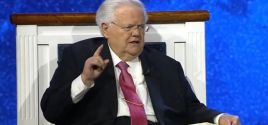Dolly creator Prof Ian Wilmut shuns cloningBy Roger HighfieldThe Telegraph Nov. 18, 2007 |
Popular 
Report: Blinken Sitting On Staff Recommendations to Sanction Israeli Military Units Linked to Killings or Rapes

America Last: House Bill Provides $26B for Israel, $61B for Ukraine and Zero to Secure U.S. Border

'Woke' Google Fires 28 Employees Who Protested Gaza Genocide

Bari Weiss' Free Speech Martyr Uri Berliner Wants FBI and Police to Spy on Pro-Palestine Activists

John Hagee Cheers Israel-Iran Battle as 'Gog and Magog War,' Will Lobby Congress Not to Deescalate
 The scientist who created Dolly the sheep, a breakthrough that provoked headlines around the world a decade ago, is to abandon the cloning technique he pioneered to create her. Prof Ian Wilmut's decision to turn his back on "therapeutic cloning", just days after US researchers announced a breakthrough in the cloning of primates, will send shockwaves through the scientific establishment. He and his team made headlines around the world in 1997 when they unveiled Dolly, born July of the year before. But now he has decided not to pursue a licence to clone human embryos, which he was awarded just two years ago, as part of a drive to find new treatments for the devastating degenerative condition, Motor Neuron disease. Prof Wilmut, who works at Edinburgh University, believes a rival method pioneered in Japan has better potential for making human embryonic cells which can be used to grow a patient's own cells and tissues for a vast range of treatments, from treating strokes to heart attacks and Parkinson's, and will be less controversial than the Dolly method, known as "nuclear transfer." His announcement could mark the beginning of the end for therapeutic cloning, on which tens of millions of pounds have been spent worldwide over the past decade. "I decided a few weeks ago not to pursue nuclear transfer," Prof Wilmut said. Most of his motivation is practical but he admits the Japanese approach is also "easier to accept socially." His inspiration comes from the research by Prof Shinya Yamanaka at Kyoto University, which suggests a way to create human embryo stem cells without the need for human eggs, which are in extremely short supply, and without the need to create and destroy human cloned embryos, which is bitterly opposed by the pro life movement. Prof Yamanaka has shown in mice how to turn skin cells into what look like versatile stem cells potentially capable of overcoming the effects of disease. This pioneering work to revert adult cells to an embryonic state has been reproduced by a team in America and Prof Yamanaka is, according to one British stem cell scientist, thought to have achieved the same feat in human cells. This work has profound significance because it suggests that after a heart attack, for example, skin cells from a patient might one day be manipulated by adding a cocktail of small molecules to form muscle cells to repair damage to the heart, or brain cells to repair the effects of Parkinson's. Because they are the patient's own cells, they would not be rejected. In theory, these reprogrammed cells could be converted into any of the 200 other type in the body, even the collections of different cell types that make up tissues and, in the very long term, organs too. Prof Wilmut said it was "extremely exciting and astonishing" and that he now plans to do research in this area. This approach, he says, represents, the future for stem cell research, rather than the nuclear transfer method that his large team used more than a decade ago at the Roslin Institute, near Edinburgh, to create Dolly. In this method, the DNA contents of an adult cell are put into an emptied egg and stimulated with a shock of electricity to develop into a cloned embryo, which must be then dismantled to yield the flexible stem cells. More than a decade ago, biologists though the mechanisms that picked the relevant DNA code that made a cell adopt the identity of skin, rather than muscle, brain or whatever, were so complex and so rigidly fixed that it would not be possible to undo them. They were amazed when this deeply-held conviction was overturned by Dolly, the first mammal to be cloned from an adult cell, a feat with numerous practical applications, most remarkably in stem cell science. But although "therapeutic cloning" offers a way to get a patient's own embryonic stem cells to generate unlimited supplies of cells and tissue there is an intense search for alternatives because of pressure from the pro-life lobby, the opposition of President George W Bush and ever present concerns about cloning babies. Prof Wilmut's decision signals the lack of progress in extending his team's pioneering work on Dolly to humans. The hurdles seem to have been overcome a few years ago by a team led by Prof Hwang Woo-Suk in South Korea, with whom he set up a collaboration. Then it was discovered Prof Hwang's work was fraudulent. "We spent a long time talking to him before discovering it was all a fraud," he said. "I never really got started again after that." And Prof Wilmut believes there is still a long way to go for therapeutic cloning to work, despite the headlines greeting this week's announcement in Nature by Dr Shoukhrat Mitalipov and colleagues at Oregon Health & Science University, Beaverton, that they cloned primate embryos. In all Dr Mitalipov used 304 eggs from 14 rhesus monkeys to make two lines of embryonic stem cells, one of which was chromosomally abnormal. Dr Mitalipov himself admits the efficiency is low and, though his work is a "proof of principle" and the efficiency of his methods has improved, he admits it is not yet a cost effective medical option. Cloning is still too wasteful of precious human eggs, which are in great demand for fertility treatments, to consider for creating embryonic stem cells. "It is a nice success but a bit limited," commented Prof Wilmut. "Given the low efficiency, you wonder just how long nuclear transfer will have a useful life." Nor is it clear, he said, why the Oregon team was successful, which will hamper attempts to improve their methods. Instead, Prof Wilmut is backing direct reprogramming or "de-differentiation", the embryo free route pursued by Prof Yamanaka, which he finds "100 times more interesting." "The odds are that by the time we make nuclear transfer work in humans, direct reprogramming will work too. I am anticipating that before too long we will be able to use the Yamanaka approach to achieve the same, without making human embryos. I have no doubt that in the long term, direct reprogramming will be more productive, though we can't be sure exactly when, next year or five years into the future." Prof Yamanaka's work suggests the dream of converting adult cells into those that can grow into many different types can be realised remarkably easily. When his team used a virus to add four genes (called Oct4, Sox2, c-Myc and Klf4) into adult mouse fibroblast cells they found they could find resulting embryo-like cells by sifting the result for the one in 10,000 cells that make proteins Nanog or Oct4, both typical markers of embryonic cells. When they studied how genes are used in these reprogrammed cells, "called induced pluripotent stem (iPS) cells", they were typical of the activity seen in an embryo. In the test tube, the new cells look and grow like embryonic stem cells. And they were also able to generate viable chimaeras from the cells, where the embryo cells created by the new method could be mixed with those of a mouse embryo to grow into a viable adult which could pass on the DNA of the reprogrammed cells to the next generation. None the less, there will have to be much work to establish that they behave like embryo cells, let alone see if they are safe enough to use in the body. Even so, in the short term they will offer an invaluable way to create lines of cells from people with serious diseases, such as motor neuron disease, to shed light on the mechanisms. Given the history of fraud in this field, the Oregon research was reproduced by Dr David Cram and colleagues at Monash University, Melbourne. "At this stage, nuclear transfer to create pluripotent stem cell lines remains an inefficient process," said Dr Cram. "De-differentiation may indeed prove to be more efficient method but there is still much research to do to optimise nuclear transfer and de-differentiation and demonstrate genetic normality after these manipulations." Prof Robin Lovell-Badge of the National Institute of Medical Research, Mill Hill, said the overall success rate of 0.7 per cent reported by the team Oregon "is still too low to be used in human studies, especially given the difficulty in obtaining eggs for research. "I do think de-differentiation is very likely to be the future - once this has been shown to work in humans (I hear rumours that it is) and to work well with a reliable cell source (that is, without too many mutations, and so on)". Britain's new Nobel prize winner and pioneer of stem cell research, Sir Martin Evans of the Cardiff School of Biosciences, commented on the Japanese work: "This will be the long-term solution." The news that Prof Wilmut is to abandon cloning was welcomed by Josephine Quintavalle on behalf of Comment on Reproductive Ethics, which is against the use of human embryos in research. "At last scientists are starting to see reason and we are going to have fact and reality, rather than hype. It could not come at a better time with the new Human Tissue and Embryos Bill having its second reading in the Lords on Monday. It is a gift to us all. We are at last going to see some common sense coming into the debate." She added this work could mark the end of proposals to create animal human hybrid embryos too, to overcome difficulties obtaining enough human eggs, since this now seems irrelevant. "If people are doubting the straight cloning process, what on earth are they are going to say about combining two different species." She is aware of the Japanese work and said it was given a cautious welcome at a recent meeting in the Vatican. "A lot of people who have looked at it with more scientific expertise than me said it is very convincing and very interesting." She added that this approach would attract more investment because it is not burdened with the ethical issues of creating and destroying embryos. Quintavalle said that the Oregon work was much more disappointing than suggested by newspaper headlines. "We read that 15,000 monkey eggs were used in order to develop the new protocol; that the current application of this protocol required 304 eggs to derive 2 embryonic stem cell lines, one of which was chromosomally abnormal, delivering an extremely low success rate of 0.7 per cent. "The researchers acknowledge that they have little idea of what separates the successes from the failures, and whilst it might be theoretically possible to repeat this research in humans it is unlikely that anybody could obtain the number of eggs necessary for such experiments. "It is also noted that the embryos created were morphologically poor and attempts at pregnancy on 77 occasions were all unsuccessful. Shoukhrat Mitalipov, the lead scientist is quoted as saying, 'No pregnancy made it even to day 25.'" |



